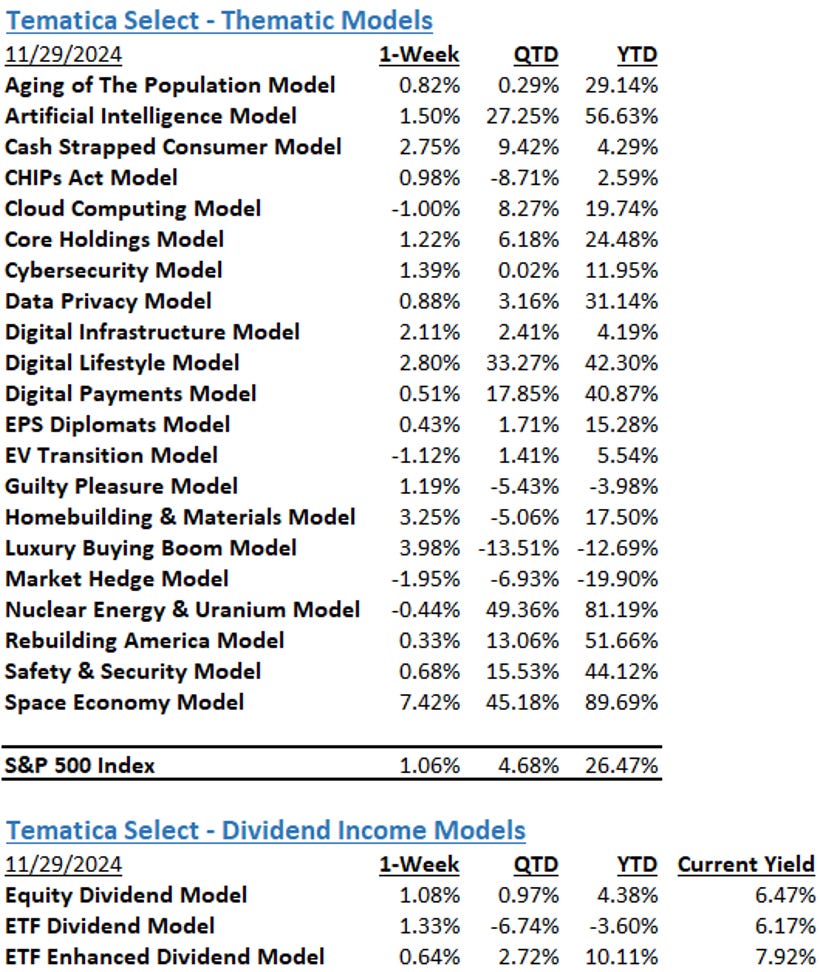November was a strong month for the stock market but is the market ahead of itself, making it time to be cautious? We discuss that in The Week Ahead video plus the Black Friday to Cyber Monday shopping weekend, what this week’s economic data means for the Fed, and review corporate earnings coming over the next few days.

The Strategies Behind Our Thematic Models
- Aging of the Population – Capturing the demographic wave of the aging population and the changing demands it brings with it.
- Artificial Intelligence – Software, chips, and related companies that facilitate the collection and analysis of large data sets and autonomous generation of solutions given non-machine language prompts.
- Cash Strapped Consumer – Companies poised to benefit as consumers stretch the disposable spending dollars they do have.CHIPs Act – Capturing the reshoring of the US semiconductor industry and the $52.7 billion poised to be spent on semiconductor manufacturing.
- Cloud Computing – Companies that provide hardware and services that enhance the cloud computing experience for users, such as co-location, security, and edge computing.
- Core Holdings – Companies that reflect economic activity and are large enough to not get pushed around by day-to-day market trends. Low-beta, large-cap names able to better withstand economic turmoil.
- Cybersecurity – Companies that focus on protecting against the penetration of digital networks and the theft, ransom, corruption or destruction of data.
- Data Privacy & Digital Identity – Companies providing the tools and services that verify authorized users and safeguard personal data privacy.
- Digital Infrastructure & Connectivity –The buildout and upgrading of our Networks, Data Storage Facilities, and Equipment.
- Digital Lifestyle – The companies behind our increasingly connected lives.
- Digital Payments – This model focuses on companies benefitting from the accelerating structural adoption of digital payments and financial technology (FinTech).
- EPS Diplomats – Profitable large capitalization companies proven to produce above-average EPS growth and provide investors with the benefit of multiple expansion.
- EV Transition – Capturing the transition to EVs and related infrastructure from combustion engine vehicles.
- Guilty Pleasure – Companies that produce/provide food and drink products that consumers tend to enjoy regardless of the economic environment and potential long-term health hazards associated with excessive consumption.
- Homebuilding & Materials – Ranging from homebuilders to key building product companies that serve the housing market, this model looks to capture the rising demand for housing, one that should benefit as the Fed returns monetary policy to more normalized levels.
- Luxury Buying Boom – Tapping into aspirational buying and affluent buyers amid rising global wealth.
- Market Hedge Model – This basket of daily reset swap-based broad market inverse ETFs protects in the face of market pullbacks, overbought market technicals, and other drivers of market volatility.
- Nuclear Energy & Uranium – Companies that either build and maintain nuclear power plants or are involved in the production of uranium.
- Rebuilding America – Turning the focused spending on rebuilding US infrastructure into revenue and profits.
- Safety & Security – Targeted exposure to companies that provide goods and services primarily to the Defense and security sectors of the economy.
- Space Economy – Companies that focus on the launch and operation of satellite networks.
The Strategies Behind Our Dividend Income Models
- Monthly Dividend Model – Pretty much what the name says – this model invests in companies that pay monthly dividends to shareholders.
- ETF Dividend Model – High-yielding ETFs that provide a range of exposures from domestic equities, international equities, emerging market equities, MLPS, and REITs.
- ETF Enhanced Dividend Model – A group of high-yielding ETFs that utilize options to enhance yield through collecting option income.
Don’t be a stranger
Thanks for reading and if you have a suggestion for an article or book we should read, or a stream we should catch, email us at info@tematicaresearch.com. The same email works if you want to know more about our thematic and targeted exposure models listed above.
